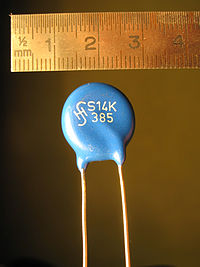
Photo from wikipedia
Silicon carbide (SiC) power MOSFETs are available only for high-power and medium-to-high-voltage applications, generally above 600 V, because for lower blocking voltages, they comparatively provide lower advantages in terms of… Click to show full abstract
Silicon carbide (SiC) power MOSFETs are available only for high-power and medium-to-high-voltage applications, generally above 600 V, because for lower blocking voltages, they comparatively provide lower advantages in terms of efficiency. There are applications, however, for which ruggedness and reliability are as important as efficiency, such as power optimizers for photovoltaic (PV) modules, which fall within the low power, low voltage category of dc–dc converters. These circuits, which maximize the energy produced by each single PV module, operate in continuously changing and stressing conditions yet having to assure high performances in terms of efficiency as well as of temperature insensitivity and long-term reliability. The aim of this paper is to predict the basic characteristics of a 4H-SiC MOSFET tailored for this kind of applications and, therefore, characterized by a breakdown voltage BVDS of 150 V and currents of the order of 10 A. The study, based on numerical simulations, shows that, besides the expected higher ruggedness, the static characteristics would be comparable to those of silicon MOSFETs rated for a comparable BVDS, with
Journal Title: IEEE Transactions on Electron Devices
Year Published: 2018
Link to full text (if available)
Share on Social Media: Sign Up to like & get
recommendations!